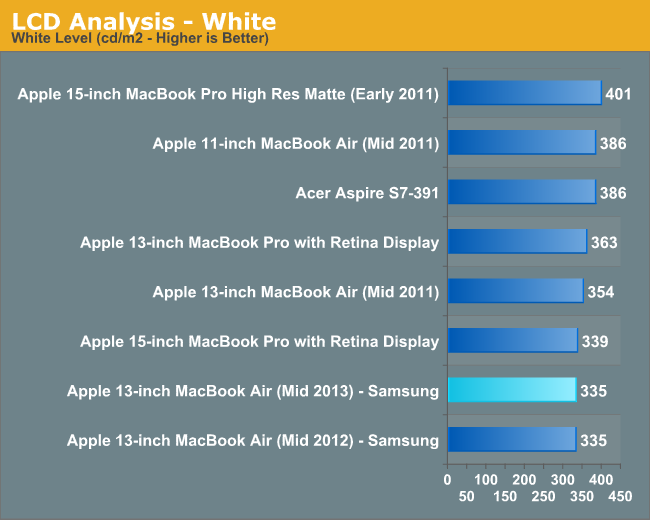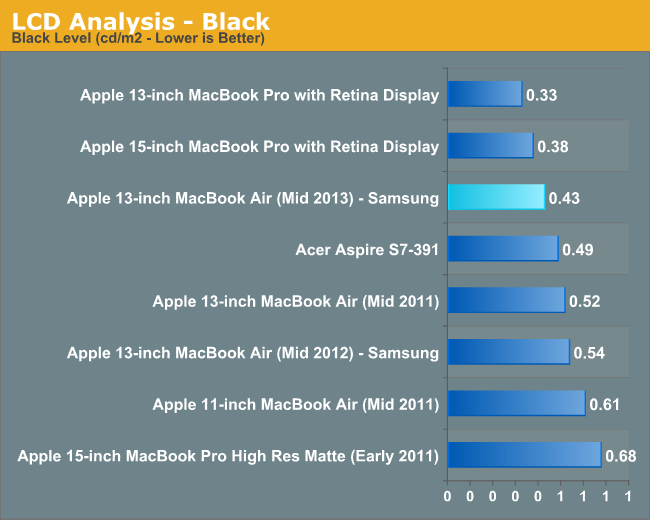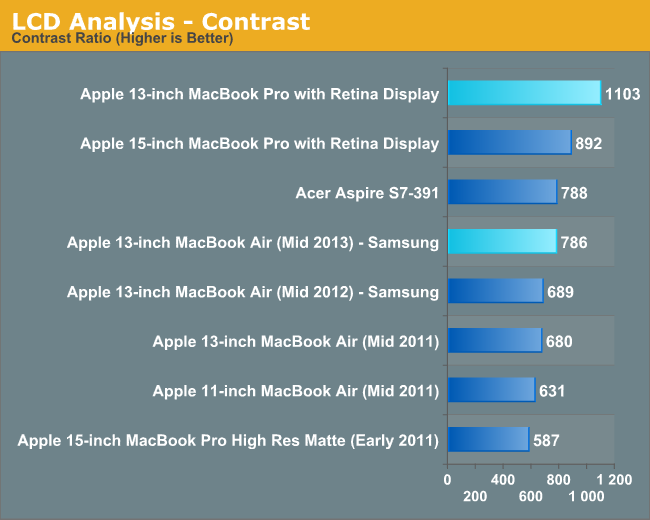The 2013 MacBook Air Review (13-inch)
by Anand Lal Shimpi on June 24, 2013 12:01 AM ESTDisplay
When I reviewed the 13-inch MacBook Pro with Retina Display, I viewed it as the true Retina MacBook Air that everyone was waiting for. With modest increases in thickness and weight, the rMBP13 gave you a much better screen and a larger battery to drive it. Apple’s lineup made sense.
After being in Taiwan earlier this month and checking out all of the 13.3-inch 2560 x 1440 displays being used on notebooks similar in size to the 13-inch MBA, I was beginning to reconsider my position.
To hit an aggressive schedule, you have to mitigate risk. In the case of the 2013 MBAs, Apple kept the chassis spec unchanged in order to do just that. As a result, the displays too, remained unchanged. We’re talking about TN panels (admittedly higher quality than most) and traditional pixel densities. Compared to the Retina Displays deployed across the rest of Apple’s product lines, these panels just aren’t as good. Compared to what you typically find elsewhere, they’re still among the best.

There are two aspects to deploying a Retina Display in a MacBook Air that are worth discussing. The first is power consumption. Greater pixel density requires a more powerful backlight to drive the panel at the same brightness, which in turn reduces battery life. Apple’s solution is to deploy Retina Displays on products it can outfit with a sufficiently large battery. I’d argue that given the battery life of the 2013 MBAs, Apple could move to a Retina Display and still deliver reasonable battery life - but it would be a regression.
The second thing to consider is price. I don’t know just how much more a Retina Display would add to the cost of a MacBook Air, but it’s clear it would be non-negligible.
There’s no real solution to the first problem, but the second one should be less of an issue as panel prices come down. I don’t know where Apple will eventually land on all of this, but today what happens is we get a well defined separation between MacBook Air and MacBook Pro with Retina Display.
Professional users who need greater color accuracy and/or additional desktop resolution really should go for the MacBook Pro with Retina Display. If you don’t need either, the MacBook Air will suffice.
In practice, the MBA’s display isn’t bad by any means. I’ve been staring at it non-stop since WWDC and don’t mind using it at all. The biggest visual issue for me is actually the shifting contrast at off-center vertical angles. It’s not a problem once you properly adjust the display angle but it’s something you don’t have to deal with on the rMBPs. When I'm not in crazy work mode, the lack of resolution isn't a huge deal - but when putting together big articles like this one, I find myself missing the rMBP quite a bit. I guess that's why the rMBP has Pro in the name.



My review sample featured a Samsung panel (LSN133BT01A02), although I’m sure the usual panel lottery is in full effect this generation as it has been in the past. Brightness and contrast are both comparable to what we had last generation (my Samsung panel this year was a bit better than last year's). The brightness/contrast results are very comparable to Acer's 1080p S7, just to show you how far Ultrabooks have come.
I ran the 2013 MBA through Chris Heinonen’s new display workflow using CalMAN to give you an idea of color accuracy vs. the rMBP:



| CalMAN Display Comparison | ||||||||
| Apple iPad (3rd gen) | Apple iPhone 5 | 13-inch rMBP (uncalibrated) | 13-inch 2013 MBA (uncalibrated) | Google Chromebook Pixel | ||||
| Grayscale 200 nits Avg dE2000 | 3.7333 | 3.564 | 1.7825 | 3.348 | 7.132 | |||
| CCT Avg (K) | 6857K | 6925K | 6632K | 6809K | 6442K | |||
| Saturation Sweep Avg dE2000 | 3.193 | 3.591 | 2.1663 | 5.3608 | 7.0927 | |||
| GMB Colorchecker Avg dE2000 | 3.0698 | 4.747 | 2.4521 | 3.9883 | 5.7664 | |||
The 13-inch MacBook Air isn’t bad, but Apple’s Retina Display is just better.













233 Comments
View All Comments
Gamingphreek - Monday, June 24, 2013 - link
Anand (or anyone else) -- I'm curious as to the effects of using Bootcamp. Doesn't bootcamp bootstrap the system into a legacy BIOS and create a fake-ish MBR? As such, aren't AHCI, EFI, and other new technologies presented in a legacy mode?For instance, on my mid-2010 MBP, I know that in bootcamp I do not have switchable graphics support and also do not have AHCI storage support.
Any comments on this functionality/limitation would be appreciated.
A5 - Monday, June 24, 2013 - link
I've never seen a $500 Ultrabook that wasn't a clearance of last year's chips. Also, the 13" is only $100 more, and the prices are pretty good for an ultraportable.Paapaa125 - Monday, June 24, 2013 - link
Show me a 1,3kg 13" Ultrabook with even a decent touchpad, 128SSD, i5 Haswell, 12h battery life for less than MBA 13" now sells. Really, it is not very expensive considering the HW you get! Not to mention great OS.Shadowmaster625 - Monday, June 24, 2013 - link
So it has Air in its name but it weighs more than 1 liter of water? Makes sense....Sm0kes - Monday, June 24, 2013 - link
Huh? I suspect marketing and branding is lost on you.Sushisamurai - Tuesday, June 25, 2013 - link
He has a point, with the new osX mavericks, a better name would be "MacBook water"seapeople - Tuesday, June 25, 2013 - link
It's actually specifically specced to equal the weight of compressed air at 3500ksi. Feel silly now? Leave the marketing to us engineers.tipoo - Monday, June 24, 2013 - link
It's been a long time since OSX vs Windows native gaming performance has been visited, I'd like to see that updated since there have been almost three OS releases since then and a small but significant influx of native games.ctwise - Monday, June 24, 2013 - link
It'll have to wait for OS/X Mavericks. That moves from OpenGL 3.x to OpenGL 4.x and, reportedly, improves performance significantly for even OpenGL 3.x clients (http://rk.md/2013/opengl-osx-mountain-lion-vs-mave...Krysto - Monday, June 24, 2013 - link
Holy cow. The Haswell chips in Airs have dropped to 1.3 Ghz now? Yikes. Before we know it Intel will claim 2W TDP for Core chips (but pay no attention to the 200 Mhz clock speed!)